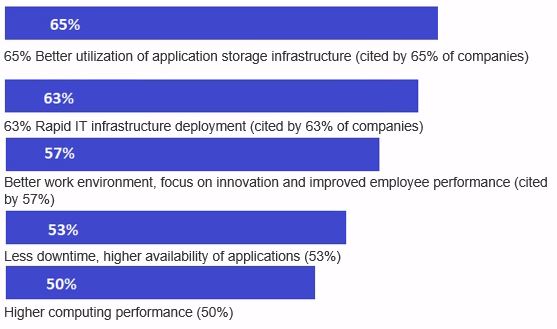A hyperconvergent infrastructure (HCI) combines computing, storage and networking into a single integrated system that can be managed as a whole.
The architecture of IT infrastructures over the past 15 years has been evolving in two principal directions, namely application deployment optimization and cost reduction. We are now past the first stage of this evolution that resulted in the consolidation of blade server and storage devices into bundles with the use of fiber cabling, as well as the advent of virtualization for cost reduction and improved performance.
At the second stage of this evolution, the principles of hyperconvergence started spreading to IT infrastructures.
The third phase, projected to last until 2025, will be the era of microservices and their integration with hyperconverged platforms.
What do you need HCI for?
Hyperconverged infrastructure (HCI) increases the speed of application delivery and deployment, and helps upgrade your systems at a lower total cost of ownership.
As recently as in 2019, HCI was predominantly employed to upgrade data centers, expand their cloud capabilities, and provide high availability and performance for mission-critical workloads. Today, however, HCI expenditures are mainly related to VDI deployment and business continuity planning. As technology becomes available, the HCI market will continue to grow. HCI is also an attractive model for private cloud infrastructures.
Advantages of Hyperconvergence
Here are the five main advantages of hyperconvergent systems according to a corporate customer poll (IDC, 2019).

In general, HCI systems make life much easier for businesses, which explains the fast growth of their popularity. Russian companies and organizations that have already embraced HCI solutions include Selgros Cash and Carry, Orenburg Bank, Baltika brewing company, the Federal Tax Service, the Federal Disability Examination Bureau of the Ministry of Labor, MGIMO University, VTB Bank, Perm Municipal Administration and many others private and public sector entities.
The future depends… on 5G
The HCI market shows strong growth. Its value is expected to reach $7.1 billion in 2021, and its annual growth rate will likely average 26.6%.
Future development of the global HCI market will be stimulated by further expansion of cloud technologies into all areas related to information processing and storage.
According to analysts, another powerful driving force behind the development of HCI will be the proliferation of 5G networks. These networks will lead to a sharp increase in the amount of data whose processing and storage will require new IT automation frameworks that will be easier to develop with the help of software-defined solutions.
In our upcoming posts we will tell about Russian and global HCI market leaders. Keep an eye out for updates!









